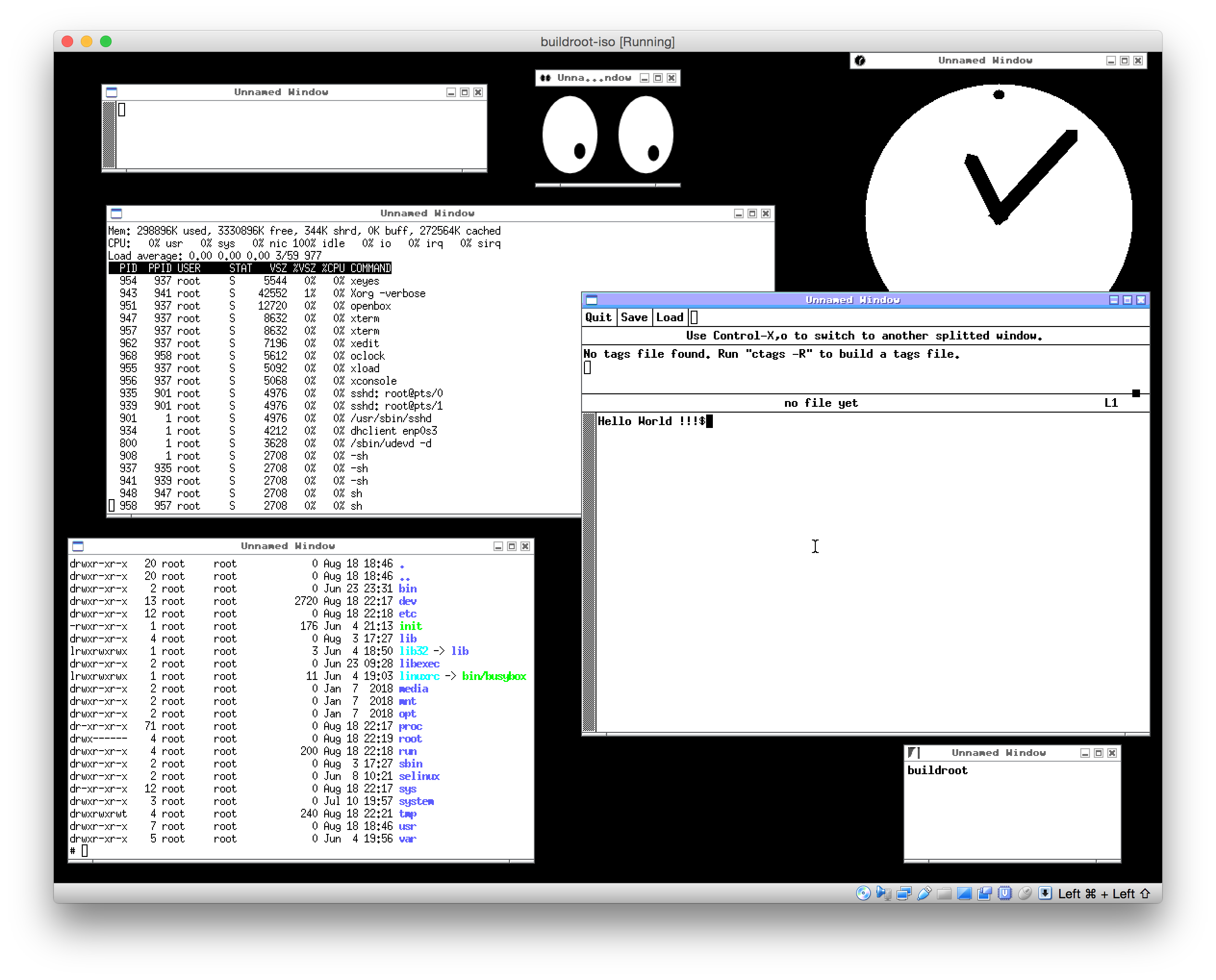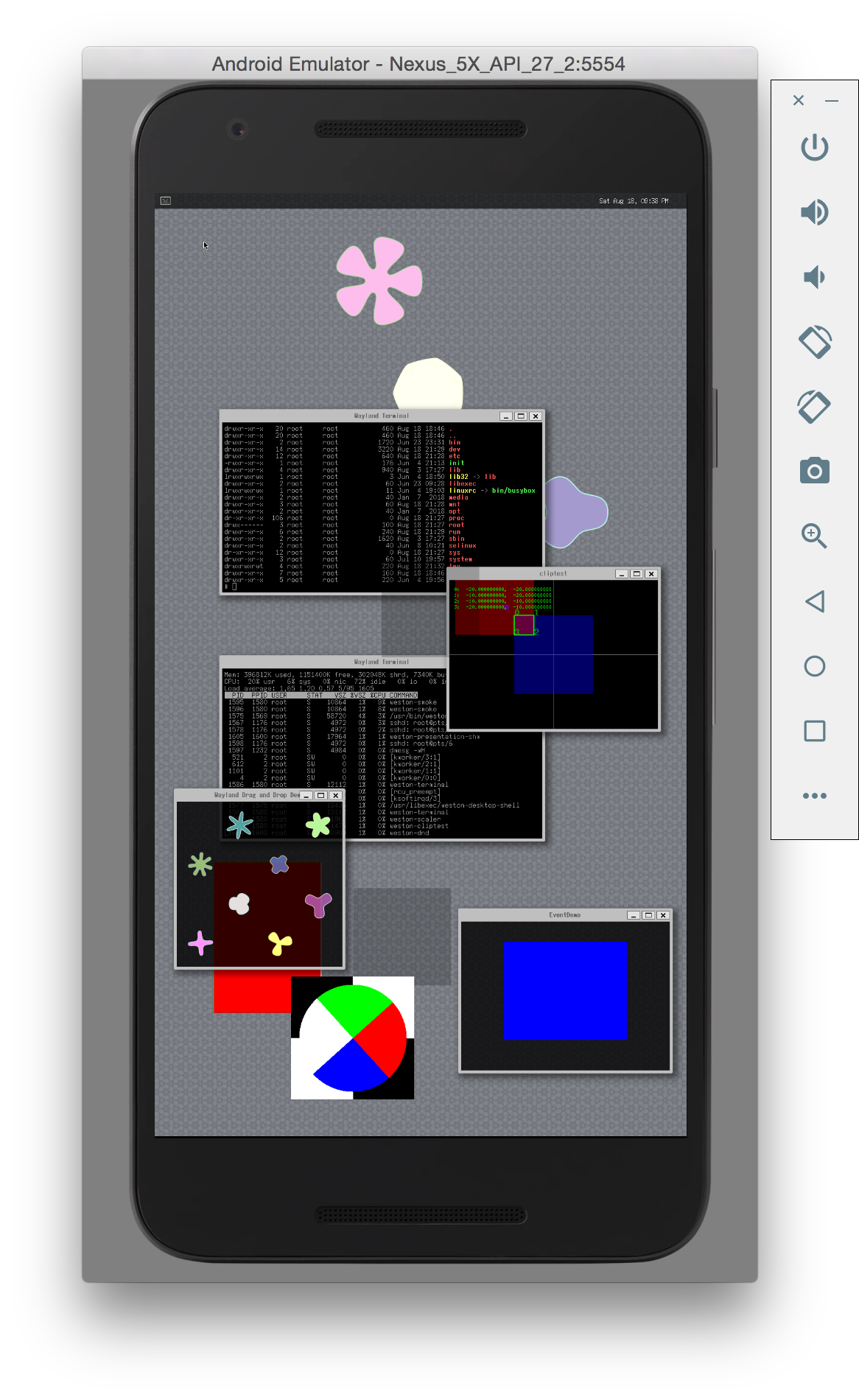Buidroot OSX - Use Buildroot on OSX natively.
With Buildroot OSX you can run a Buildroot environment natively on your Apple OSX system. You can have a cross compile environment directly on your Mac without being forced to wrap a Linux system first into a virtual machine. There is no need to setup up a Linux container like Valgrind, Docker or VirtualBox. You can simply use your Mac development tools and file system as they are.
This is achieved by
- preparing a clean build environment in a shell
- wrapping the Xcode toolchain to cope with unknown compiler args
- providing patches for host packages to make them compile on OSX
Currently, the build creates an ISO system image with Busybox that can start from Qemu or VirtualBox.
The Buildroot make system expects some basic tools to be available as described in the "Mandatory packages" section of the Buildroot "System Requirements".
We need the following tools:
- autoconf
- automake
- awk
- bash
- bc
- binutils
- bzip2
- coreutils
- cpio
- diffstat
- diffutils
- dot
- egrep
- file
- findutils
- getopt
- getconf
- git
- grep
- gzip
- libtool
- m4
- make
- patch
- perl
- python
- rsync
- sed
- sh
- tar
- unzip
- wget
- which
- xzcat
Most of the tools might be already available on your Mac, but we need the GNU based versions to reduce incompatibilities compared with a Linux system. You can find them directly on the GNU ftp server at http://ftp.gnu.org/gnu/ or use any package manager to install them on your Mac. In this guide we use Homebrew - The missing package manager for macOS to fulfil this task.
Since the Linux build requires a case sensitive file system, the native "Mac OS Extended" file system is not sufficient. We need to create an image that holds all build artefacts.
hdiutil create -size 20g -type SPARSE -fs "Case-sensitive HFS+" -volname brosx brosx.sparseimage
hdiutil attach brosx.sparseimage
In the build environemt we use the following directory structure. The names in braces refer to environment variables used in this guide.
/Volumes/brosx # mounted image root (BROSX_ROOT)
├── buildroot # home folder with buildroot git project is checked out (BROSX_HOME)
└── toolchain # links to the Xcode toolchain wrapper (BROSX_TOOLCHAIN)
└── tools # links to binaries of other required tools (BROSX_TOOLS)
After mounting the file system, we can enter the build root folder and clone the Buildroot OSX repository and checkout our desired branch, e.g.
cd /Volumes/brosx
git clone git@github.com:generia/buildroot.git
cd buildroot
git checkout osx10
Configure the build tools as they are installed on your Mac. There is a template at support/brosx/brosx.sh in the repository that helps to setup the environent.
The configuration shown in that template was actually used to run the Busybox build.
cp /Volumes/brosx/buildroot/support/brosx/brosx.sh /Volumes/brosx
The shell setup template is split into three parts. The first part defines basic folder variables. The second defines all variables that refer to the necessary tools installed on your Mac. These tools have been installed as described before. The second part contains some helper logic that configures the PATH and sets up links so that the tools can be found properly.
The basic folder variables are
BROSX_ROOT=/Volumes/brosx
BROSX_HOME=$BROSX_ROOT/buildroot
BROSX_TOOLS=$BROSX_ROOT/tools
BROSX_TOOLCHAIN=$BROSX_ROOT/toolchain
The tool variables follow four certain patterns that are used by the setup logic.
1. BROSX_<tool>_CMD=<tool-installation-file>
2. BROSX_<tool-set>_HOME=<tool-set-installation-folder>
3. BROSX_<tool-set>_GHOME=<gnu-prefixed-tool-set-installation-folder>
3. BROSX_TOOLCHAIN_CMD_<tool>=<tool-installation-file>
- The first pattern defines single executables that reside somewhere on your Mac. The setup logic will create a link to each of them under
BROSX_TOOLS. - The second pattern defines a folder that contains only executables forming a tool-set. The setup logic will add this folder to the
PATH. - The third pattern defines a folder that contains gnu-tools that are installed with a "g" prefix. Since this is convention is not used in a Linux envirnment we strip the "g" prefix and link the base tool name in a folder under
$BROSX_ROOT/opt/<tool-set>/bin. The tool-set folder with those links will be added to thePATH. - The fourth pattern configures the toolchain wrapper that is used to filter the calls to the Xcode toolchain. The setup logic links all tools to a single
toolchain-wrapper-xcode.sh. This wrapper determines the link target via the variable value. Before calling the actual compiler tool the arguments are parsed, to filter out arguments which are not known to Xcode.
To aid debugging the toolchain wrapper supports logging. The logging can be turned on/off by defining a log file.
BROSX_TOOLCHAIN_WRAPPER_LOG_DIR=$BROSX_HOME/ouput/build
# leave log-file empty to turn logging off
#BROSX_TOOLCHAIN_WRAPPER_LOG_FILE=
BROSX_TOOLCHAIN_WRAPPER_LOG_FILE=$BROSX_TOOLCHAIN_WRAPPER_LOG_DIR/.toolchain-wrapper-xcode.log
After setting up all required locations in brosx.sh, you can start a clean shell and source the setup
# NOTE: bash version 4.x required
env -i bash --noprofile --norc
source /Volumes/brosx/brosx.sh
The build shell environment is now ready to use.
The build on OSX does not cover all packages. So far the build works for a default builtroot busybox configuration based on Linux kernel 4.14.10 with some extensions for iso image generation and some simple target tools, like file or htop. See graph-depends diagram below for the packages involved.

The test build can be reproduced with the defconfig
make defconfig BR2_DEFCONFIG=support/brosx/configs/brosx_busybox_iso_defconfig
Running make will start the full build
make
The result will be in 'output/images/rootfs.iso9660'. You can run the image directly with Qemu.
qemu-system-i386 -cdrom output/images/rootfs.iso9660
You can also rename the image to *.isoand lauch it with VirtualBox.
It was tested on
- OSX 10.10 Yosemite
- Xcode 6.4
The build takes about 35 min on 2,5 GHz Intel Core i7 with 16 GB 1600 MHz DDR3.
For a standard GNU autotool or cmake build things are working fairly reliable. Issues came into play, if the package at hand is "aware" of an Apple build environment. Since the build runs natively the uname of your build system still reports some "darwin" system. This leads usally to build failures, since the target system is actually linux but the build may be misled to some OSX/BSD Unix environment.
To resolve this, the parts that detect the build system has to be spotted and it has to be checked, if the build process can be forced to assume a specific build system, e. g. by setting up some make parameters.
Currently, buildroot-osx is capable of building sysetm images that run Xorg or Wayland/Weston.
Example of Xorg using Openbox built with brosx running on VirtualBox hardware:

Example of Wayland/Weston built with brosx running on Android Emulator hardware:

